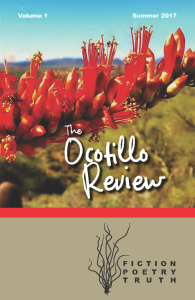After more than a few months of work by several dedicated volunteers the initial issue of The Ocotillo Review has come to fruition. We were diligent enough getting the word out to receive well over 400 submissions for our debut publication. I read every one. I assured the editors of each genre that I wouldn’t influence their decisions on which submissions we chose to publish. I just like to read. So I don’t consider the slush pile a slush pile. I consider it a treasure chest, maybe a chest with many dull stones, but a treasure chest nonetheless. The cool thing about treasure is sometimes you don’t know what you have until you dust it off a little. Other times you may find a gemstone while you’re looking for gold.
As I explored the treasure chest I found a few submissions that either appeal to me on a personal level or looked at a well-worn trope from a new dimension. Some of these were already chosen by the editors, some were not. Some I felt had been submitted in the wrong category and needed a little restructuring to become part of our vision for this publication. I decided to publish these as my editor’s choice pieces. During the weeks prior to our publications on July 1 we will post a few of these pieces on our website to give you, the reader, a small taste of what’s to come.
One of the most rewarding things about these few months has been communicating with the authors of these wondrous pieces. I don’t think I’ve had the pleasure of working with a more generous, accepting, and knowledgeable group of artists in any field. I am overwhelmed with the positive responses I’ve had to the editorial comments, even in the rare cases where we did deep revisions. We are looking forward to promoting more work from underserved and eclectic writers alongside established and award-winning authors. We invite you to acquire a copy of The Ocotillo Review for yourself and another for a friend who appreciates quality literature. Thank you for your support.
This week’s Internet offering is a nonfiction piece titled The Diagnosis of Dr. Gupta by Jonathan Smulian. Jonathan travels widely in his career as a professional civil engineer. I think you’ll find this analysis of medical care both entertaining and thought-provoking. Enjoy.
The Diagnosis of Doctor Gupta
The monsoon season had finally reached Jamshedpur. That afternoon torrents of rain had flooded the crowded streets. An Indian engineer colleague and I walked back to our hotel after dinner dodging both stagnant puddles and hundreds of shift workers from the Tata Steel plant weaving their way home on their bicycles. He wanted to get back to watch the Test cricket on television. I didn’t feel well and wanted to go to bed. I thought it might have been the rich lamb curry and pungent chutney.
The next morning I felt nauseous with a pain in my lower right abdomen but was determined to participate in the blessing of the planning team’s new project office. My Indian associates had hired a part-time priest from the vegetable market to perform the “puja.” After the priest had smeared his forehead with paste, lit the incense burner, squatted in the corner with his bowls of oil, some fruit and garlands of orange marigolds, he began to chant the blessing. To include me among the blessed, he placed a red dot of colored paste on my forehead .The “puja” chant droned on and on for what seemed an eternity. I felt so ill I just had to leave.
“I’ll just go to the hotel and lie down for a few hours,” I said.
“Should we call a doctor?” The young Indian engineers asked looking concerned about their aged foreign consultant.
“Not necessary. I’ll be back this afternoon.” I replied. An hour later as I lay on my bed there was a knock on the door .To my surprise, there appeared my three Indian colleagues and a mild looking middle-aged man with a large mustache, a long soiled white coat and a shabby black bag. He was introduced as Doctor Gupta. He didn’t seem to speak much English and, without asking for my permission, began to examine me. With a very elongated forefinger he proceeded to prod my stomach, saying only “Pain?” with each prod. Eventually, after prodding
and prodding, he found a tender spot , grunted, packed up his stethoscope and bag and nodding his head from side to side announced—“Gall bladder infection.”
“Better in three days,” and finally—“will happen again in about six weeks.” He then took out an old blue-lined school exercise book, tore out a page and with a blunt pencil wrote out a prescription.
With another nod of his head he left my room and my colleagues rushed off to the local chemist returning with some powders wrapped in twisted cylinders of old newspaper and a few pills wrapped in a crumpled sheet of torn silver paper marked “Made in India.”
“But I didn’t pay him for the visit” I said.
“Don’t worry,” they replied, “we gave him 400 rupees.”
“400 rupees. Ten US dollars for a hotel visit and examination,” I exclaimed. “I must pay him a reasonable fee.”
“No,” they insisted, “that is the normal charge and he was pleased to get it.”
After agonizing about the potential consequences I decided to take Doctor Gupta’s mysterious medicines. I felt better immediately and in three days felt completely healthy. Ten days later I flew back to Houston.
Five weeks passed. On a Saturday morning (My family, or our house pets, are in the habit of only taking ill on weekends), I felt the exact same nausea and pain as I had in India and drove to a well-known Houston multi-specialty clinic. The internist who normally acted as our family doctor was absent and a skeleton staff were on week-end duty.
“Mmm,” said a doctor I had not seen before, “probably appendicitis and you should have a CAT scan.” She sent me to an emergency clinic about a mile away where I was thoroughly examined again by two young doctors who, having done an extensive series of tests and discussed the case at length over a period of hours, thought it might just be an appendix problem. They eventually sent me to radiology for a CAT scan. Half an hour later came the verdict .
“Gall bladder infection.” “Make an immediate appointment with a gastroenterologist.” I saw that the bill for the process leading to that Saturday morning’s diagnosis, paid later by my health insurance of course, was $2,450.
When I told my internist the story of Doctor Gupta’s $10 diagnosis she said. “Well , it is sad, but with our reliance on our high tech equipment we may well have lost our ability to diagnose common symptoms.”
On my next visit to India I called on Doctor Gupta and presented him with a formal testimonial letter, that I had designed and written in Houston, resplendent with red wax seals, italic script on headed paper and signed with a flourish, praising him for his outstanding diagnostic skills. My Indian friends tell me that this testimonial, in an elaborate gilt frame with carved elephants entwined with wreathes of lotus flowers, is hanging in a place of honor on the wall of Doctor Gupta’s modest Jamshedpur surgical suite.
Jonathan Smulian (Houston TX USA)is a retired International Urban Planning Consultant who lived in 12 countries and worked in 32. Born in South Africa 1930, he has a UK and US nationality. He writes media articles and op-ed pieces and has been published in professional and technical journals This his first submission to a literary publication.


